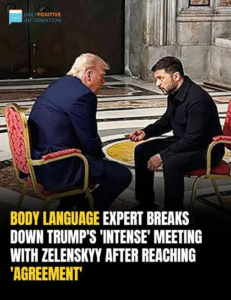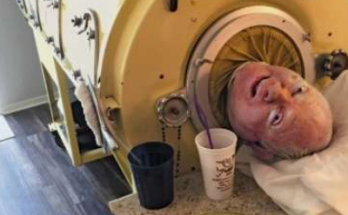A recent meeting between former U.S. President Donald Trump and Ukrainian President Volodymyr Zelenskyy has sparked intense public and media interest—not just for its political implications but also for the body language on display. Despite headlines proclaiming that an “agreement” was reached, body language experts are pointing to subtle nonverbal cues that suggest deep tension, unease, and a lack of genuine connection between the two leaders.
According to several analysts, the handshake that opened the meeting was the first clue. Trump, known for his assertive and often dominant handshakes, grasped Zelenskyy’s hand firmly and pulled him slightly forward, a classic power move. Zelenskyy, however, maintained a stiff posture and avoided prolonged eye contact. This, experts say, indicated discomfort or emotional distance. “There was no warmth in that greeting,” noted one expert. “It was performative, not personal.”
As the two sat down for the press portion of their meeting, both leaders adopted contrasting body positions. Trump leaned back with his legs apart and arms draped loosely—a display of confidence and territorial control. Zelenskyy, in contrast, sat upright with tightly folded hands, suggesting guardedness and restraint. “His posture was defensive. It’s the posture of someone bracing for impact,” another analyst observed.
Eye contact, or the lack thereof, was another revealing factor. Trump frequently looked around the room or toward the cameras, rarely locking eyes with Zelenskyy for more than a second or two. Zelenskyy mostly stared straight ahead or at the floor. Body language experts interpret this as mutual distrust. “If two people are truly aligned and cooperative, they naturally make more eye contact,” one noted. “This meeting lacked that synchrony.”
Even when both leaders spoke of their “shared goals” and a “constructive discussion,” their facial expressions told a different story. Trump’s signature smirk returned several times, which experts often interpret as a sign of skepticism or underlying sarcasm. Zelenskyy’s tight-lipped smile and furrowed brow hinted at stress or dissatisfaction. “It’s clear Zelenskyy wasn’t entirely comfortable with the optics of this meeting,” one body language professional stated. “It felt like he was enduring it, not engaging in it.”
The setting of the meeting also contributed to the overall tension. The overly staged photo-op environment, with flags and handlers nearby, seemed to emphasize optics over substance. Analysts suggest that both leaders may have been more focused on how the meeting would be perceived than on forming a genuine rapport.
In the end, while the meeting concluded with official statements of progress and agreement, the body language painted a more complicated picture. What the words didn’t say—the stiffness, the hesitation, the lack of mutual ease—spoke volumes. For a world watching closely, especially amid ongoing geopolitical uncertainty, this subtle language may reveal more about the state of U.S.-Ukraine relations than any carefully crafted press release.

